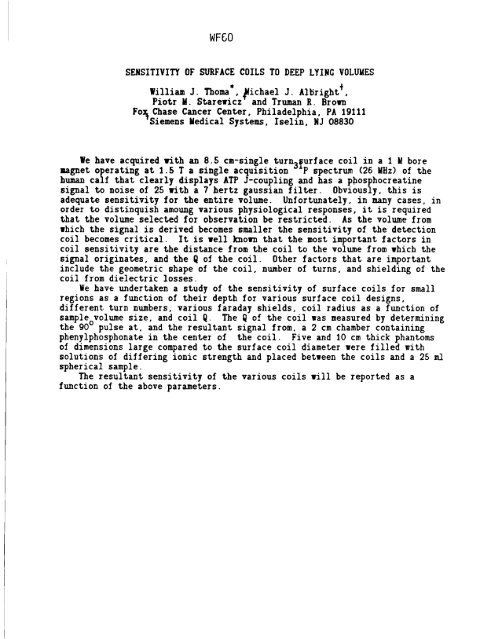th - 1987 - 51st ENC Conference
th - 1987 - 51st ENC Conference
th - 1987 - 51st ENC Conference
You also want an ePaper? Increase the reach of your titles
YUMPU automatically turns print PDFs into web optimized ePapers that Google loves.
WF60<br />
SENSITIVITY OF SURFACE COILS TO DEEP LYING VOLUMES<br />
William J. Tboma , ~ichael J. Albright ~,<br />
Piotr M. Starewicz" and Truman R. Brown<br />
Fo~Chase Cancer Center, Philadelphia, PA 19111<br />
Siemens Medical Systems, Iselin, NJ 08830<br />
Ne have acquired ri<strong>th</strong> an 8.5 cm-single turn3[urface coil in a 1M bore<br />
magnet operating at 1.5 T a single acquisition P spectrum (26 MHz) of <strong>th</strong>e<br />
human calf <strong>th</strong>at clearly displays ATP J-coupling and has a pbosphocreatine<br />
signal to noise of 25 wi<strong>th</strong> a 7 hertz gaussian filter. Obviously, <strong>th</strong>is is<br />
adequate sensitivity for <strong>th</strong>e entire volume. Unfortunately, in many cases, in<br />
order to distinquish amoung various physiological responses, it is required<br />
<strong>th</strong>at <strong>th</strong>e volume selected for observation be restricted. As <strong>th</strong>e volume from<br />
which <strong>th</strong>e signal is derived becomes smaller <strong>th</strong>e sensitivity of <strong>th</strong>e detection<br />
coil becomes critical. It is well known <strong>th</strong>at <strong>th</strong>e most important factors in<br />
coil sensitivity are <strong>th</strong>e distance from <strong>th</strong>e coil to <strong>th</strong>e volume from which <strong>th</strong>e<br />
signal originates, and <strong>th</strong>e Q of <strong>th</strong>e coil. O<strong>th</strong>er factors <strong>th</strong>at are important<br />
include <strong>th</strong>e geometric shape of <strong>th</strong>e coil, number of turns, and shielding of <strong>th</strong>e<br />
coil from dielectric losses.<br />
We have undertaken a study of <strong>th</strong>e sensitivity of surface coils for small<br />
regions as a function of <strong>th</strong>eir dep<strong>th</strong> for various surface coil designs,<br />
different turn numbers, various faraday shields, coil radius as a function of<br />
sample volume size, and coil Q. The Q of <strong>th</strong>e coil was measured by determining<br />
<strong>th</strong>e 90 ° pulse at, and <strong>th</strong>e resultant signal from, a 2 cm chamber containing<br />
phenylphosphonate in <strong>th</strong>e center of <strong>th</strong>e coil. Five and 10 cm <strong>th</strong>ick phantoms<br />
of dimensions large compared to <strong>th</strong>e surface coil diameter were filled wi<strong>th</strong><br />
solutions of differing ionic streng<strong>th</strong> and placed between <strong>th</strong>e coils and a 2S ml<br />
spherical sample.<br />
The resultant sensitivity of <strong>th</strong>e various coils rill be reported as a<br />
function of <strong>th</strong>e above parameters.













